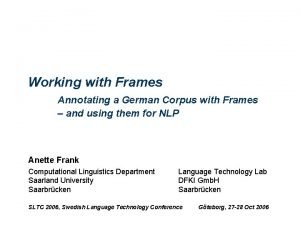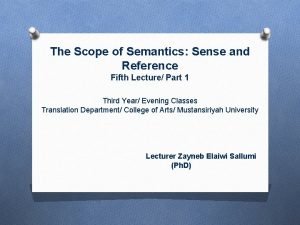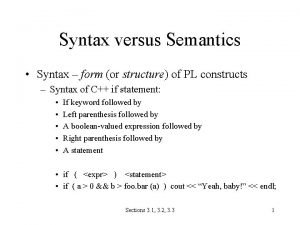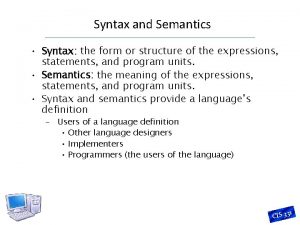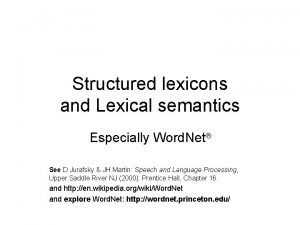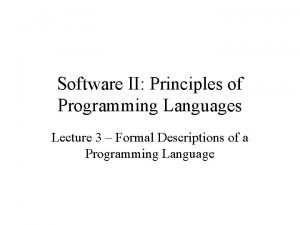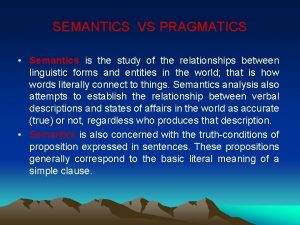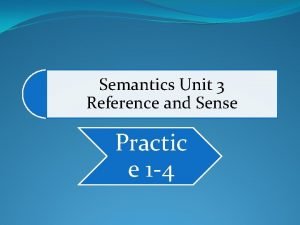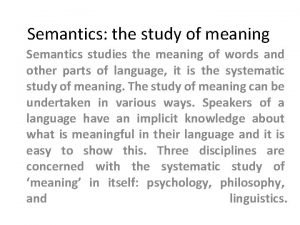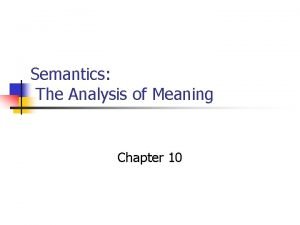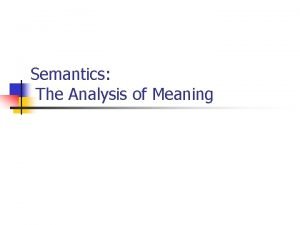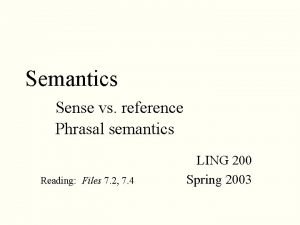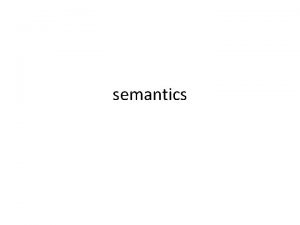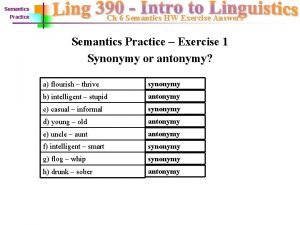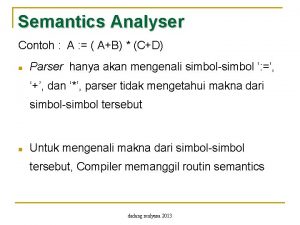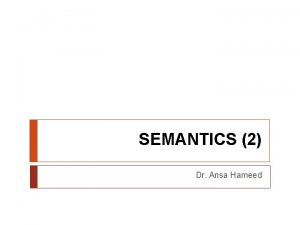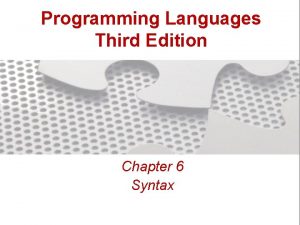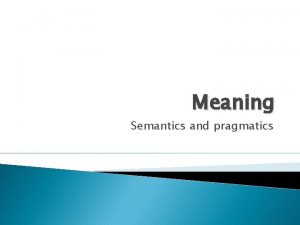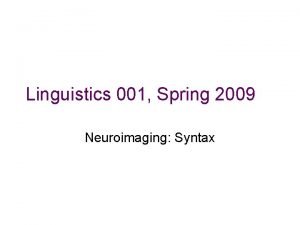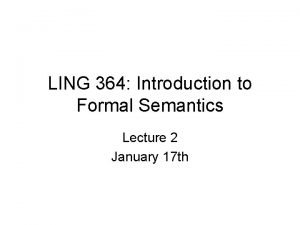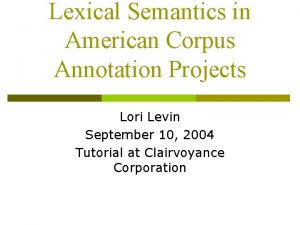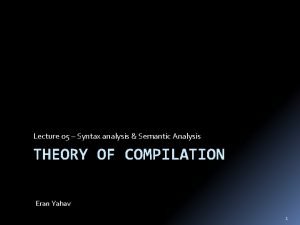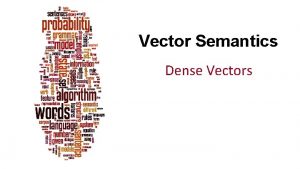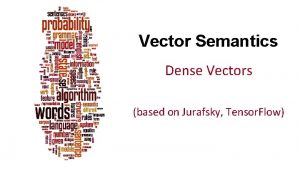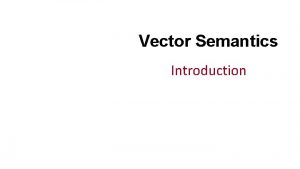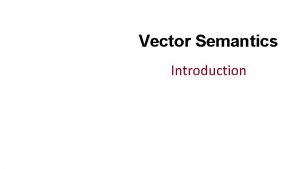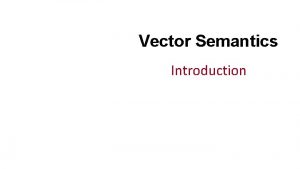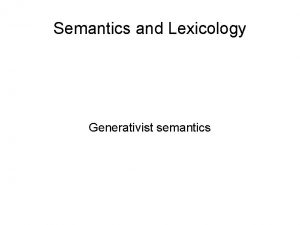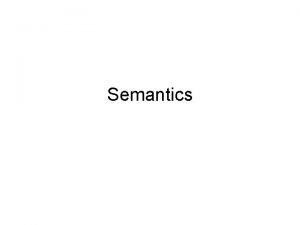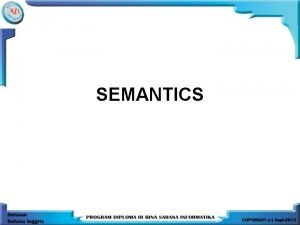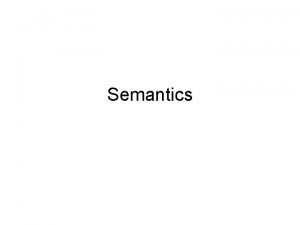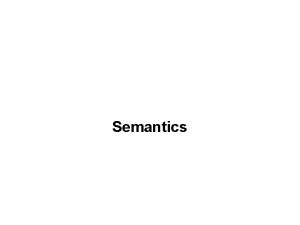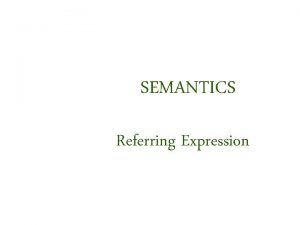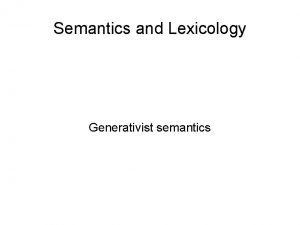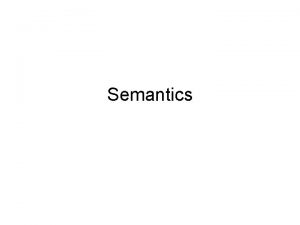Vector Semantics Dan Jurafsky Why vector models of

















































- Slides: 49

Vector Semantics

Dan Jurafsky Why vector models of meaning? computing the similarity between words “fast” is similar to “rapid” “tall” is similar to “height” Question answering: Q: “How tall is Mt. Everest? ” Candidate A: “The official height of Mount Everest is 29029 feet” 2

Dan Jurafsky Word similarity for plagiarism detection

Dan Jurafsky Word similarity for historical linguistics: semantic change over time Sagi, Kaufmann Clark 2013 Semantic Broadening 45 40 <1250 35 Middle 1350 -1500 30 Modern 1500 -1710 25 20 15 10 5 0 dog 4 deer hound Kulkarni, Al-Rfou, Perozzi, Skiena 2015

Dan Jurafsky Distributional models of meaning = vector-space models of meaning = vector semantics Intuitions: Zellig Harris (1954): • “oculist and eye-doctor … occur in almost the same environments” • “If A and B have almost identical environments we say that they are synonyms. ” Firth (1957): • “You shall know a word by the company it keeps!” 5

Dan Jurafsky Intuition of distributional word similarity • Nida example: A bottle of tesgüino is on the table Everybody likes tesgüino Tesgüino makes you drunk We make tesgüino out of corn. • From context words humans can guess tesgüino means • an alcoholic beverage like beer • Intuition for algorithm: • Two words are similar if they have similar word contexts.

Dan Jurafsky Four kinds of vector models Sparse vector representations 1. Mutual-information weighted word co-occurrence matrices Dense vector representations: 2. Singular value decomposition (and Latent Semantic Analysis) 3. Neural-network-inspired models (skip-grams, CBOW) 4. Brown clusters 7

Dan Jurafsky Shared intuition • Model the meaning of a word by “embedding” in a vector space. • The meaning of a word is a vector of numbers • Vector models are also called “embeddings”. • Contrast: word meaning is represented in many computational linguistic applications by a vocabulary index (“word number 545”) • Old philosophy joke: Q: What’s the meaning of life? A: LIFE’ 8

Dan Jurafsky Term-document matrix • Each cell: count of term t in a document d: tft, d: • Each document is a count vector in ℕv: a column below 9

Dan Jurafsky Term-document matrix • Two documents are similar if their vectors are similar 10

Dan Jurafsky The words in a term-document matrix • Each word is a count vector in ℕD: a row below 11

Dan Jurafsky The words in a term-document matrix • Two words are similar if their vectors are similar 12

Dan Jurafsky Term-context matrix for word similarity • Two words are similar in meaning if their context vectors are similar 13

Dan Jurafsky The word-word or word-context matrix • 14

Dan Jurafsky … …

Dan Jurafsky Word-word matrix • 16

Dan Jurafsky 2 kinds of co-occurrence between 2 words (Schütze and Pedersen, 1993) • First-order co-occurrence (syntagmatic association): • They are typically nearby each other. • wrote is a first-order associate of book or poem. • Second-order co-occurrence (paradigmatic association): • They have similar neighbors. • wrote is a second- order associate of words like said or remarked. 17

Vector Semantics Positive Pointwise Mutual Information (PPMI)

Dan Jurafsky Problem with raw counts • Raw word frequency is not a great measure of association between words • It’s very skewed • “the” and “of” are very frequent, but maybe not the most discriminative • We’d rather have a measure that asks whether a context word is particularly informative about the target word. • Positive Pointwise Mutual Information (PPMI) 19

Dan Jurafsky Pointwise Mutual Information •

Dan Jurafsky Positive Pointwise Mutual Information •

Dan Jurafsky Computing PPMI on a term-context matrix • Matrix F with W rows (words) and C columns (contexts) • fij is # of times wi occurs in context cj 22

Dan Jurafsky p(w=information, c=data) = 6/19 =. 32 p(w=information) = 11/19 =. 58 p(c=data) = 7/19 =. 37 23

Dan Jurafsky • pmi(information, data) = log 2 (. 32 / (. 37*. 58) ) =. 58 (. 57 using full precision) 24

Dan Jurafsky Weighting PMI • PMI is biased toward infrequent events • Very rare words have very high PMI values • Two solutions: • Give rare words slightly higher probabilities • Use add-one smoothing (which has a similar effect) 25

Dan Jurafsky • 26 Weighting PMI: Giving rare context words slightly higher probability

Dan Jurafsky Use Laplace (add-1) smoothing 27

Dan Jurafsky 28

Dan Jurafsky PPMI versus add-2 smoothed PPMI 29

Vector Semantics Measuring similarity: the cosine

Dan Jurafsky Measuring similarity • • 31 Given 2 target words v and w We’ll need a way to measure their similarity. Most measure of vectors similarity are based on the: Dot product or inner product from linear algebra • High when two vectors have large values in same dimensions. • Low (in fact 0) for orthogonal vectors with zeros in complementary distribution

Dan Jurafsky Problem with dot product • Dot product is longer if the vector is longer. Vector length: • Vectors are longer if they have higher values in each dimension • That means more frequent words will have higher dot products • That’s bad: we don’t want a similarity metric to be sensitive to 32 word frequency

Dan Jurafsky Solution: cosine • Just divide the dot product by the length of the two vectors! • This turns out to be the cosine of the angle between them! 33

Dan Jurafsky Cosine for computing similarity Dot product Unit vectors vi is the PPMI value for word v in context i wi is the PPMI value for word w in context i. Cos(v, w) is the cosine similarity of v and w Sec. 6. 3

Dan Jurafsky Cosine as a similarity metric • -1: vectors point in opposite directions • +1: vectors point in same directions • 0: vectors are orthogonal • Raw frequency or PPMI are nonnegative, so cosine range 0 -1 35

Dan Jurafsky large data computer apricot 2 0 0 digital 0 1 2 information 1 6 1 Which pair of words is more similar? cosine(apricot, information) = cosine(digital, information) = cosine(apricot, digital) = 36

Dan Jurafsky Visualizing vectors and angles 37 large data apricot 2 0 digital 0 1 information 1 6

Dan Jurafsky 38 Clustering vectors to visualize similarity in co-occurrence matrices Rohde et al. (2006)

Dan Jurafsky Other possible similarity measures

Vector Semantics Measuring similarity: the cosine

Dan Jurafsky Using syntax to define a word’s context • Zellig Harris (1968) “The meaning of entities, and the meaning of grammatical relations among them, is related to the restriction of combinations of these entities relative to other entities” • Two words are similar if they have similar syntactic contexts Duty and responsibility have similar syntactic distribution: Modified by additional, administrative, assumed, collective, adjectives congressional, constitutional … Objects of verbs assert, assign, assume, attend to, avoid, become, breach. .

Dan Jurafsky Co-occurrence vectors based on syntactic dependencies Dekang Lin, 1998 “Automatic Retrieval and Clustering of Similar Words” • Each dimension: a context word in one of R grammatical relations • Subject-of- “absorb” • Instead of a vector of |V| features, a vector of R|V| • Example: counts for the word cell :

Dan Jurafsky Syntactic dependencies for dimensions • Alternative (Padó and Lapata 2007): Instead of having a |V| x R|V| matrix Have a |V| x |V| matrix But the co-occurrence counts aren’t just counts of words in a window But counts of words that occur in one of R dependencies (subject, object, etc). • So M(“cell”, ”absorb”) = count(subj(cell, absorb)) + count(obj(cell, absorb)) + count(pobj(cell, absorb)), etc. • • 43

Dan Jurafsky PMI applied to dependency relations Hindle, Don. 1990. Noun Classification from Predicate-Argument Structure. ACL Object of “drink” Count PMI it tea 3 2 1. 3 11. 8 anything liquid 3 2 5. 2 10. 5 wine 2 9. 3 tea anything 2 3 11. 8 5. 2 liquid it 2 3 10. 5 1. 3 • “Drink it” more common than “drink wine” • But “wine” is a better “drinkable” thing than “it”

Dan Jurafsky Alternative to PPMI for measuring association • tf-idf (that’s a hyphen not a minus sign) • The combination of two factors • Term frequency (Luhn 1957): frequency of the word (can be logged) • Inverse document frequency (IDF) (Sparck Jones 1972) • N is the total number of documents • dfi = “document frequency of word i” • = # of documents with word I • wij = word i in document j wij=tfij idfi

Dan Jurafsky tf-idf not generally used for word-word similarity • But is by far the most common weighting when we are considering the relationship of words to documents 46

Vector Semantics Evaluating similarity

Dan Jurafsky Evaluating similarity • Extrinsic (task-based, end-to-end) Evaluation: • Question Answering • Spell Checking • Essay grading • Intrinsic Evaluation: • Correlation between algorithm and human word similarity ratings • Wordsim 353: 353 noun pairs rated 0 -10. sim(plane, car)=5. 77 • Taking TOEFL multiple-choice vocabulary tests • Levied is closest in meaning to: imposed, believed, requested, correlated

Dan Jurafsky Summary • Distributional (vector) models of meaning • Sparse (PPMI-weighted word-word co-occurrence matrices) • Dense: • Word-word SVD 50 -2000 dimensions • Skip-grams and CBOW • Brown clusters 5 -20 binary dimensions. 49
 Dan jurafsky nlp
Dan jurafsky nlp Dan jurafsky nlp slides
Dan jurafsky nlp slides Hey hey bye bye
Hey hey bye bye Compare procedural semantics and declarative semantics.
Compare procedural semantics and declarative semantics. Jurafsky & martin
Jurafsky & martin Vector resolution examples
Vector resolution examples Vector semantics
Vector semantics What is the difference between models & semi modals
What is the difference between models & semi modals Dont ask why why why
Dont ask why why why Why business models matter
Why business models matter Directed line segment definition
Directed line segment definition Vector unitario de un vector
Vector unitario de un vector Position vector diagram
Position vector diagram Why-why analysis
Why-why analysis Wh tongue twister
Wh tongue twister Does this table represent a function why or why not
Does this table represent a function why or why not Does this table represent a function why or why not
Does this table represent a function why or why not Why or why not
Why or why not Contoh analisis akar masalah
Contoh analisis akar masalah Aki karusmäki
Aki karusmäki Examples of sense and reference in semantics
Examples of sense and reference in semantics Syntax vs semantics
Syntax vs semantics Syntax vs semantics
Syntax vs semantics Lexicon antonym
Lexicon antonym Grammar vs syntax vs semantics
Grammar vs syntax vs semantics Pragmatics example
Pragmatics example Sense vs referent
Sense vs referent Study of meanings
Study of meanings Polysemy examples
Polysemy examples Semantics means
Semantics means Hyponyms examples for grade 3
Hyponyms examples for grade 3 What are entailments
What are entailments The study of the meaning of words
The study of the meaning of words Presupposition examples sentences
Presupposition examples sentences Utterance definition linguistics
Utterance definition linguistics Lexical universals meaning
Lexical universals meaning Lexical and grammatical meaning examples
Lexical and grammatical meaning examples Semantic exercise
Semantic exercise Contoh a
Contoh a Three challenges in doing semantics
Three challenges in doing semantics Dr ansa
Dr ansa Syntax programming
Syntax programming Difference between semantics and pragmatics
Difference between semantics and pragmatics Componential analysis
Componential analysis Example of semantics in linguistics
Example of semantics in linguistics Formal semantics examples
Formal semantics examples Lexical semantics
Lexical semantics Syntax vs semantics
Syntax vs semantics Communicative theory of translation
Communicative theory of translation Semantics vs pragmatics
Semantics vs pragmatics

